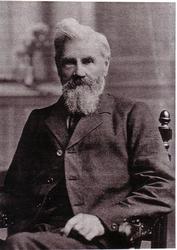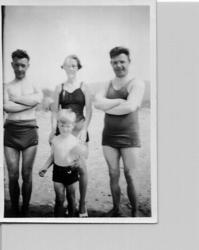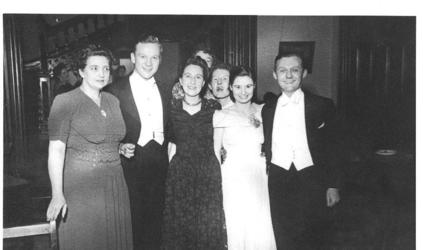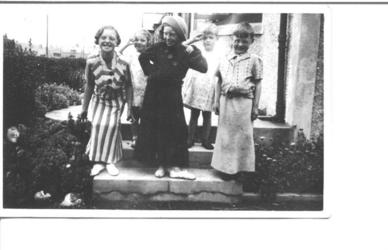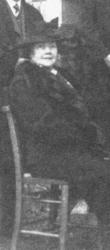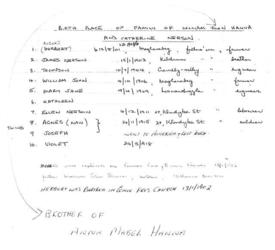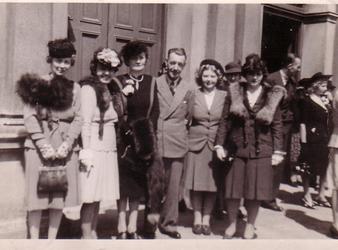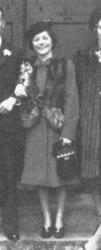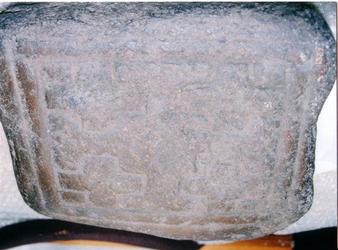About Taggart/Mawhinney/Hanna/Dickson - Cobwebs in the Attic
Please sign our GUEST BOOK!
History with its flickering lamp stumbles along the trail of the past, trying to reconstruct its themes, to revive its echoes and kindle with pale gleams the passion of former days.
The name TAGGART is a modern form of the word "Sagard", the Gaelic form of "Sacred", derived from "Sacerdos", which means a priest of sacrificial rank. In the seventh century, about 671 A.D., Saint Maelrubha, Abbot of Beaunchair [Bangor], Ireland, went into Scotland and established a great religious house at Applecross on the west coast of Ross Shire. The domains of this monastery became very, very great, and over the centuries, regardless of political and religious setbacks, became a very powerful and influential force. This included the First Macan-Sagard, Farquhar, becoming the first Earl Of Ross of the Making-Taggart line in about 1215 A.D. The "clan" Ross had been founded by Paul McenTire [or McEntire] starting in the 12 century by uniting with the Rosses seven smaller clans or cepts; namely, the Andrews, Andersons, Gillanders, McenTire's, McTears, MacTaggart and TAGGARTS.
Now we're going back home. During the many decades following the Knighting of Ferquhard, members of the old Ross and Taggart stock came down from time to time into the lowlands of Scotland, and William, the Fifth Earl of Ross of the Making-Taggart line, settled many in Galloway in 1292 when the King granted him a Sheriffdom of Skye in Argyle. Across the waters in Ireland was County Antrim, which became essentially Scottish, and was eventually settled alike by Highlanders and Lowlanders,and it is said "that about Ballymena the Irish language was never spoken".
Kintyre, the nearest point to Ireland, is just 13 miles from the County Antrim coast. The affiliations of the Taggart family with the lowland Scots give color to the claim that it had sojourned in Galloway for many generations before returning to Ireland. Indeed, perhaps over 500 years had passed before the family returned to Ireland, whence it came. Here it spread over county Antrim, giving names to several localities and towns.
TAGGARTSLAND is a division of a county called a townland. It corresponds, although somewhat smaller in dimensions, with our township and included several parishes. A part of Donegore and Kilbride parishes, the ancient burial place of the Taggart family, is in Taggarts Land. There is a Taggarts Town near Randallstown and another between Belfast and Antrim. But the political turmoil and religious persecutions weren't over yet. Over the next several centuries, depending on whose side you were on, family fortunes fluctuated, especially during the time of Cromwell, whom many of the Taggarts opposed. By 1745, both the Ross Clan in Scotland and the Taggart family in Ireland were dwindling in numbers and many of the members sought relief from persecutions by emigrating to the American Colonies and Canada.
MAWHINNEY - what does Mawhinney surname mean?
This Gaelic surname recorded as Mawhinney, McWhinnie, McWhinney, McWeeney, McQueeney, and several other forms, is an Anglicized form of the Old Scots Mac Shuibhne, which translates as 'the sonm of the pleasant one'. The surname first appears on record in mid 13th Century, (see below), and has a very confused etymology, being associated directly with the clan MacKenzie, but also in Ireland being a synonym for the famous clan Buchanan. Today the surname is most associated with Ulster, and in particular County Antrim, but in earlier times it was most prominent in County Fermanagh, some fifteen families being recorded in Petty's Census of Ireland undertaken in 1659. Early recordings from the Scottish homeland include Ewin Makkenye was 'son and air' to Kenyeoch Maksorle of the Black
Isle in the year 1500, and Alan McConze who was tenant of Culcowe, Ardmanoch in 1504. Other early recordings include Donal Mikenye of Kilravock in 1513, and Gilcrist Makkingze of Wigtownshire in 1513. William McQuhinny of the parish of Carsfern was recorded in 'The Register of the Privy Seal of
Scotland' in 1684 The first recorded spelling
of the family name is shown to be that of Makbeth Makkyneth, which was dated 1264, in the rolls of 'Pleas held at Dull, Angus', during the reign of Alexander 111 of Scotland, 1249 - 1286. Surnames became necessary when governments introduced personal taxation. In England this was known as Poll Tax. Throughout the centuries, surnames in every country have continued to 'develop' often leading to astonishing variants of the original spelling.
HANNA http://www.clanhannay.us/sorbie.html
A quote from the writing of the Reverend James A. Mac C. Hanna, in his book "Hanna of Castle Sorbie and Descendants"; seems a very appropriate way to start this historical outline of our origin, history and descendancy: "The Hanna family, is so ancient that its earlier years are hidden in the mists and moors of the homeland. We have many reliable records from the 13th century to the present date that this Celtic family has been an honorable one in every phase of human activity. What, indeed, a great name and heritage to pass on to our descendants!".
For more complete history of our family’s development through the ages, this writer refers to reader
to the above publication, and the works of Stewart Hannay Francis, "the Hannays of Sorbie". This was
never intended to be a scholarly work, but merely an outline to familiarize the reader with the origins of his race, heritage and the background leading to the descendancy of our particular line of the family Hanna. Both of the above named publications are available from the Clan Hannay Society, Great Britain;
Hanna family legend holds that one Patrick A’hannay, who lived around the time of 1150 AD, was the first known to use the surname Hanna. He is therefore assumed to be, and is accepted as the progenitor of our race. He would have been the son of the "Hanna", the last man to have a given name
only. Further identification to have been his occupation, place of birth or abode, or some physical characteristic.
There is earlier record of a priest named Hanna, who may have been a Bishop, who was alive around the year 1098 AD. The thought that he may be one of our ancestors is extremely dim, though quite possible. There is a long history of our men in the clergy.
The first appearances, on record, of the name is a document know as the "Ragman’s Roll", of 1296 AD.
When England’s King Edward I had his Scottish Barons swear fealty to him by signing this roll of landed gentry. Gilbert De Annethe and Gilbert De Hannethe were signators of record. They were the owners of record of the lands of Sorbie (about the year 1250 AD), in the county of Wigton, Halloway,
in southern Scotland. The two Gilberts may have been father and eldest son. The son would have been heir.
The thirteenth century seem to be the time when surnames came into common use in Scotland.
Our family is considered to be of the Pictish/Gaelic origin. The Picts and Gaels were both Celtic (p. Keltic) peoples. The Celts originated in the Alpine headwaters of the Danube River in central Europe more that 8500 years ago. The Celts at that time had already developed the oldest European culture that has continued through the ages to the present; predating the Greek and Roman civilizations by thousands of years. They spread eastward to central Anatolia (now known as Turkey) and were known, in biblical times, as the Galatians. These people were well known to the ancient Greeks who called them Keltoi, their word for barbarian.
The first human settlements in Scotland date back some 8500 years. These were pre-Celtic, stone-age peoples, dark skinned much like the Mediterranean people. These first settlers were food gatherers (foragers) and possibly fishermen. Later, came the Celts, with the discovery of metals and the development of alloys with which to make tools for clearing the dense forests, hunting and still later, farming societies came into being.
The Celts spread westward across what is now southern Germany, Belgium, northern Italy, France, and much of Spain and Portugal, and had settled in the British Isles long before the roman Empire arose.
There are ancient cairns (stone burial chambers) located on the Hannay estate at Kirkdale, built by the Celts, that date back some 3500 years. Celtic migrations to, and settlement of, Britain commenced at least 1000 years ago. They conducted trade with Greece and the Phoenicians and other Mediterranean civilizations. Timothy, in his pre-apostolic days, traded with the Belgic tribes of Britain, for tin to be alloyed with copper for the making of bronze.
As the Roman Empire began to emerge, Rome had much contact with Gaul, as the Romans called the lands
to the north. The Romans used the word that the Celts used to refer to themselves. There were times of peaceful trade; and times of warfare. Rome eventually conquered Gaul including Britain, with the exception of the Caledonian (Scottish) highlands. The Pictish tribe that the Romans met and conquered in Galloway were known as the Novanti. After several attempts to conquer the Highland Picts; Rome gave up in despair and built a wall, the Antonine wall built by and named for the future
Emperor of Rome, North of a line drawn from present day Glasgow to Edinburgh, to seal the barbaric Picts out of the roman Empire. Many years later, Hadrian (later Emperor of Rome) gave up trying to control even the southern Picts. He built the wall, named after him, which runs along the present border between Scotland and England. Galdus, the last Pictish king to do battle against the Roman Legions, is know to be buried on the Hannay lands at Kirkdale. Pict, by the way, is the Roman word for, the northern Britons, meaning picture, as these people tattooed their bodies with a blue dye.
At about the time The Empire was commencing its decline, the Irish of the kingdom of Dalriada, in Ulster (Northern Ireland), started their invasions of the Hebrides Islands, the Western Highlands, Strathclyde and Galloway; to establish the Kingdom of New Dalriada. These Irish invaders were the Gaels who make up the Gaelic part of our Pictish/Gaelic ancestry.
These Gaels were named Scotii (meaning thieves) by the Romans. They eventually conquered the Picts and the new Kingdom of Scotland came into being. The Picts had been driven eastward into the Grampian highlands, where their culture and language eventually died out. The only thing we know of their culture today is their wonderful artistic designs of stylized animal and knotwork graphics and
sculptures.
The Empire of Rome declined as the Germanic hordes came out of central Asia and eventually took over
all of the territory that once was Gaul, with the exception of Brittany in northern France and the area in present day Spain known as Gallicia. Ireland, in all of this, managed to escape these invasions with the exception of the coming of the Gaels from Spain, many centuries earlier.
The Germanic tribes, Angles and Saxons, invaded and conquered most of southern Britain, including parts of southeastern Scotland, to establish Angleland (English) language. Celtica had been reduced to Wales, Cornwall, and most of Scotland, in Britain; the Isle of Man, Ireland; Brittany and Gallicia, on the continent.
In the second Century AD, St. Ninian, a Briton, founded his mission, Candida Casa, at the Isle of Whithorn, just a few short miles south from the Estates at Sorbie. It was the first Christian Church
established on Scottish soil. An early outpost of the ancient Celtic Church, it later was adopted into the Roman Catholic Church. Pilgrimages to the shrine at Whithorn were made by Royalty and the faithful for more than a millennium thereafter.
In family lore, the Hannas were firmly established in Galloway in the ninth century AD.
It was in the ninth and tenth centuries that the Vikings from present day Denmark and Norway, conducted their bloody raids and began to establish settlements. The Vikings controlled the Scottish
northern island groups of the Shetlands and Orkneys, the western Hebrides Islands; settlements all around the Scottish, Irish and English coasts.
The first cities in the Celtic lands of Scotland, Ireland and the Isle of Man were established by the Vikings. The Celts never established any know cities until after their conquering by peoples of other cultures. The Celts were, and still prefer to be agrarian and pastoral by nature, whereas the Mediterranean and Germanic peoples are more urbane. This is probably the reason that the Celtic peoples have declined in numbers over the centuries. Although a warrior race, with few exception, did they ever establish any community, over a small tribe, with sufficient numbers, to repel a conquering force, or; create a conquering force, of their own, to ensure their own survival.
In the eleventh century, through a series of bloody wars, England was defeated at the battle of Hastings in the year 1066 AD by William the Conqueror, the Bastard Duke of Normandy. The ensuing Norman kings granted large tracts of land to those Norman knights and Peers who swore fealty to the crown. Their Baronages included lands anywhere in the British Isles, not just England.
As a result, the de Vetereponts, a powerful Norman family, acquired the lands of Sorbie and are the first owners of record, in the ancient province of Galloway in southwestern Scotland, the heartland of our Hanna Family.
How the Sorbie lands came into the possession of the Hannay family is unknown, but through the passage of many events that are beyond the scope of this outline, it did come to pass (refer to Stuart Hannay Francis’ book, "The Hannays of Sorbie"). It is known for many years the family in ownership called themselves Sorbie or de Sorbie, after the name of the estate. This is still a common practice today. However a family named Sorby did come into being, who today claim attachment to Sorbie tower. They may well have become the Hannays who were the next owners, while some retained
the Sorby name. Documents dated in 1488 refer to Odo Sorbie, while his sons are clearly shown as Hannays.
Odo de Sorbie is the first known Hannay to own the Sorbie estate, and from him an unbroken line can be traced to the breakup of the Sorbie branch and then on to the present Kirkdale branch. Which is now the Chiefly line of the family.
Up to the mid 1600’s the Hannays were a most powerful influence in Wigstonshire ( shire = County). They held sway over Wigtown and the Machers (from Gaelic machair = pastureland). In fact, for many years they were known as the Machers Hannay, which cover a large area of the Wigton peninsula on the
south coast of Galloway.
Through a series of economically devastating feuds (private wars) from the late 16th century to the mid 17th century, the Hannays of Sorbie came to their ruin. Branded as outlaws, many of the family found themselves in the Ulster Plantations. After selling off the estate to cover his indebtedness, John Hannay, last Laird of Sorbie found himself in Ulster, in 1640, where he died later in that year.Think how exciting it would be to discover a book that told all about the family of your great-great-grandmother or grandfather, or anyone else in your family line. This web sit is a chance for you to make such a discovery possible for descendants. Pass it on to your children.
Please feel free to go to PRINT and make copies so that you will have this info for all times. Living in this world of computers may not always make saving data safe.
Hope that you will like the following poem and that it will stir up old memories.
I'll speak to you, dear stranger, if you really want to know, So listen , and I'll tell you why I love this city so.
Belfast is an Ulsterman with features dour and grim,
It's a pint of creamy porter and a Sunday morning hymn;
The dingy little café where they serve you dainty teas.
It's up the road to the anchor, for lots of vinegar on hot peas.
It's a banner on July the twelfth, a sticky toffee apple, A righteous little gospel hall, a roman catholic chapel;
It was a paper boy shouting telly, a piece of apple tart
A fry upon a Saturday, or a coal creek on a cart.
Do you mind a Corporation gas man, complete with bowler hat, A wee shop at the corner, a friendly bit of chat;
An old lad in a duncher, the woman in a shawl,
A pinch of snuff, a tattie fil, a loyal orange hall.
The tobacco smell in York street, a beg of yellow man,
An Easter egg that's dyed with wings, a slice of or pan
The wee lad with pricks in an owl glass jar,
The preacher at the customs house, or an old Victorian bar.
Mud banks on the Lagan when the tide is running low,
The men collecting refuse , bonfires in sandy row;
A bag of salty dulles, a bowl of Irish stew,
A goldfish bought in Gresham Street, a preacher at the queue. It's a portrait of King Billy upon a gable wall,
A flower seller on a stool, outside the city hall;
A half moon round the door step, a police man on guard,
A man whose crying "delf for regs", a little whitewashed yard.
It's the Mays market on a Friday, the ships lined at the docks, It's a shiny polished fender, a bunch of green shamrocks; It's herrings fried in oaten meal, with a drink of buttermilk; It's a snowy linen handkerchief as soft as finest silk,
O'Hara's bap with country butter, a dander round the zoo, A climb up tough Ben Madigan to get a splendid view.
It's a bunch of savoury scallions, a plate of buttery champ, Hopscotch on the footpath, a swing around a lamp,
Delf dogs on the mantelpiece, the wee man from the pru,
The chimney sweep on his bicycle, coming to do the flue;
The ever present vista of the hills of Castlereagh,
The deathless hush on Saturday when Linfield play away,
Killarney's lakes and fells, on the bells of the assembly hall, Spikey broken bottles stuck on the backyard wall.
It's bacon boiled with pamphrey, served when piping hot,
With scary spuds, balls of flour, cracked laughing in the pot. It's the smell of mansion polish on the lino in the hall, Sunday school excursion, a treat for one and all;
It's the Islandmen who build great ships that take us far to sea, S.D. bells in Ann Street where they sell the finest tea;
It's fish and chips in paper, on a Friday from Johnny longs; The sally army band on Sunday to save the sinning throng.
It's a wee walk up the Lisburn Road and back by the Malone, The Albert clock in High Street with its rich and mellow tone. It's a barney Hughes hot cross bun, a canary in a cage,
The old men talking in the park of a past and better age;
It's the sharp expressive dialect of everyone at large,
A ton of coal on the Lagan a floating in a barge.
It's women on the windy stool when the summer sun shines down, A "v" of apple tattie or a wee race into town.
It's a needle to an anchor in Smithfield's famous mart, I think I'd better call a halt before I break my heart.
And that's the answer stranger and now I'm sure you'll see, Why Belfast is the only place in all the world for me.
Based on an original idea
By Bill Nesbitt
Please sign our Guest Book and let us know you were here. Thank you.
|
LOADING! Please wait ...
LOADING! Please wait ...
Getting Around
There are several ways to browse the family tree. The Tree View graphically shows the relationship of selected person to their kin. The Family View shows the person you have selected in the center, with his/her photo on the left and notes on the right. Above are the father and mother and below are the children. The Ancestor Chart shows the person you have selected in the left, with the photograph above and children below. On the right are the parents, grandparents and great-grandparents. The Descendant Chart shows the person you have selected in the left, with the photograph and parents below. On the right are the children, grandchildren and great-grandchildren. Do you know who your second cousins are? Try the Kinship Relationships Tool. Your site can generate various Reports for each name in your family tree. You can select a name from the list on the top-right menu bar.
In addition to the charts and reports you have Photo Albums, the Events list and the Relationships tool. Family photographs are organized in the Photo Index. Each Album's photographs are accompanied by a caption. To enlarge a photograph just click on it. Keep up with the family birthdays and anniversaries in the Events list. Birthdays and Anniversaries of living persons are listed by month. Want to know how you are related to anybody ? Check out the Relationships tool. |

LOADING! Please wait ...
LOADING! Please wait ...
|

